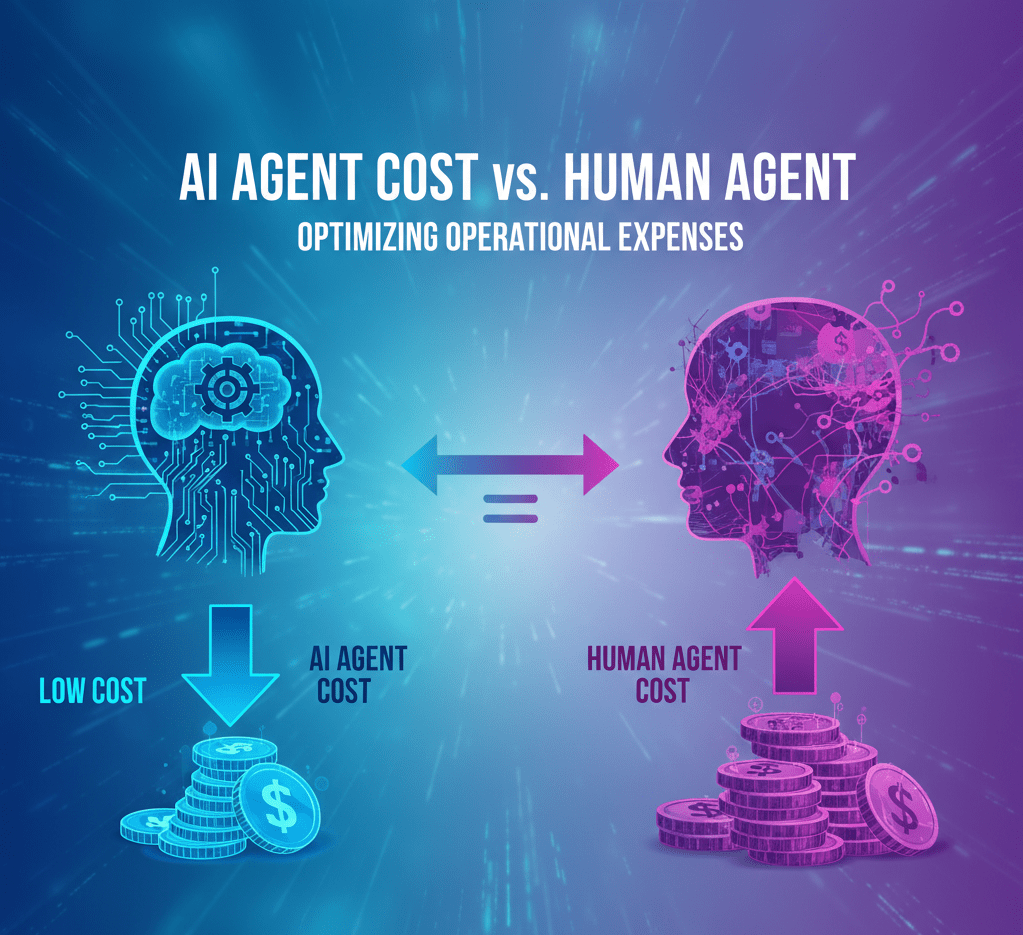“See 3,392% ROI by comparing AI agent cost vs. human agent TCO, showing AI’s 24/7 scalability and consistency for a fraction of the fully-loaded $83,820 human cost.”
You’re constantly looking at the numbers. Every business owner and financial decision-maker is. You’re under relentless pressure to boost operational efficiency, slash costs, and improve the bottom line. In this high-stakes environment, every line item on your profit and loss (P&L) statement is under scrutiny, especially labor costs. You’ve heard the buzz about Artificial Intelligence, and the question keeps coming up: Can an AI agent really save us money?
The simple answer is yes. But “cheaper” doesn’t even begin to tell the whole story. A surface-level comparison misses the point entirely. To truly grasp the financial impact, you need to go deeper. You need a comprehensive, data-driven analysis that treats this decision like any other significant capital investment. It’s about understanding the Total Cost of Ownership (TCO) and the full range of capabilities that each option offers.
This isn’t just another article hyping up AI. This is a detailed financial breakdown designed for people who think in terms of spreadsheets, ROI, and strategic advantage. We will meticulously deconstruct the actual, fully loaded annual cost of a human agent and compare it to that of a modern AI agent. We’ll explore the operational limitations of a traditional workforce versus the game-changing potential of automation.
And finally, we’ll introduce a seismic shift in this calculation—a way to achieve an almost immediate, undeniable return on investment. Let’s run the numbers and find out what makes the most sense for your business.
The Human Agent: Uncovering the True Cost of Employment
When considering the cost of an employee, the first number that comes to mind is their salary. That’s a natural starting point, but it’s dangerously misleading. The base salary is just the tip of the iceberg. The fully-loaded cost—what an employee actually costs your business each year—is significantly higher. To make an informed decision, we have to account for every single dollar. Let’s build a realistic cost profile for a single U.S.-based customer support or lead qualification agent.
Base Salary
First, we need a baseline. The role of a customer service representative or a sales development representative (SDR) is foundational in many businesses. According to data from Glassdoor, Payscale, and the Bureau of Labor Statistics, a competitive salary for a skilled agent in the U.S. in 2025 falls in a reasonably predictable range.
Let’s use a conservative, round number for our calculation.
- Average Annual Salary: $50,000
This is the number everyone sees, but it’s where the hidden costs begin to pile up.
Payroll Taxes and Benefits: The 30% Rule of Thumb
This is the single most significant addition to your labor cost. For every dollar you pay in salary, you pay a considerable percentage more in mandatory taxes and competitive benefits. These aren’t optional; they are the cost of doing business and attracting talent.
- Payroll Taxes (FICA): The Federal Insurance Contributions Act tax is split between the employer and employee. It funds Social Security (6.2%) and Medicare (1.45%). Your share as the employer is 7.65% of the employee’s salary.
- Calculation: $50,000 x 7.65% = $3,825
- Unemployment Taxes (FUTA/SUTA): Federal and state unemployment taxes are paid by the employer. The rate varies, but a blended average is around 2% (this can be higher or lower depending on your state and claims history).
- Calculation: $50,000 x 2% = $1,000
- Health Insurance: Offering health insurance is crucial for attracting and retaining employees. The Kaiser Family Foundation reports that the average annual premium for employer-sponsored single coverage is over $8,000. Employers typically cover about 80% of that cost.
- Average Employer Contribution: $6,500
- Retirement Contributions (401(k) Match): A standard 401(k) matching program provides 50% of the employee’s contribution, up to 6% of their salary. Assuming the employee takes full advantage, you would contribute 3% of their salary.
- Calculation: $50,000 x 3% = $1,500
- Paid Time Off (PTO): Employees don’t work every day. You pay them for vacations, holidays, and sick days. The average U.S. worker gets around 10 vacation days, eight sick days, and 10 federal holidays. That’s 28 days of paid time when they are not actively working.
- Calculation: ($50,000 / 260 workdays) x 28 days = $5,385
- Workers’ Compensation: This insurance protects your business in the event that an employee is injured on the job. The rate varies wildly by industry and state, but a reasonable estimate for an office worker is about $0.50 per $100 of payroll.
- Calculation: ($50,000 / 100) x $0.50 = $250
Just adding these costs brings our total so far to $68,460, already a 37% increase over the base salary. But we’re not done yet.
Recruiting, Onboarding, and Training
Finding and preparing a new employee is a massive, often underestimated, expense.
- Recruiting Costs: This includes advertising the job on platforms like LinkedIn, the time your hiring managers spend reviewing resumes and conducting interviews, and potentially a recruiter’s fee (which can be 15-20% of the salary). Let’s be conservative and estimate the amortized cost of internal recruiting efforts.
- Estimated Annualized Cost: $2,000
- Onboarding and Training: A new hire isn’t productive on their first day. The first month often involves intensive training on your products, systems, and company policies. During this time, you’re paying their full salary plus the salary of the managers and trainers involved. This “lost productivity” has a real cost.
- Estimated Annualized Cost: $4,000
Overhead, Equipment, and Software
Your agent needs a place to work and tools to do their job. These per-employee overhead costs are a critical part of the TCO calculation.
- Workspace Overhead: This refers to the employee’s share of office rent, utilities, internet, and office supplies. Even with remote work, there are often stipends or equipment costs associated with the position.
- Estimated Annual Cost: $5,000
- Hardware and Equipment: A computer, monitor(s), headset, desk, and chair are standard issue. This equipment needs to be purchased and periodically replaced.
- Estimated Annualized Cost (amortized over 3 years): $1,000
- Software Licenses: This is a big one. Your agent needs access to a suite of tools to be effective.
- CRM (e.g., Salesforce): ~$150/month
- Customer Support Platform (e.g., Zendesk, Intercom): ~$100/month
- Communication (e.g., Slack, Microsoft 365): ~$30/month
- Total Monthly Software Cost: $280
- Annual Software Cost: $280 x 12 = $3,360
The Final Tally: Total Cost of Ownership for a Human Agent
Let’s put it all together.
| Cost Component | Annual Cost |
| Base Salary | $50,000 |
| Payroll Taxes (FICA, FUTA/SUTA) | $4,825 |
| Health Insurance | $6,500 |
| 401k Match | $1,500 |
| Paid Time Off (PTO) | $5,385 |
| Workers’ Compensation | $250 |
| Subtotal: Benefits & Taxes | $18,460 |
| Recruiting & Onboarding | $2,000 |
| Training | $4,000 |
| Subtotal: Hiring & Development | $6,000 |
| Workspace Overhead | $5,000 |
| Hardware & Equipment | $1,000 |
| Software Licenses | $3,360 |
| Subtotal: Infrastructure & Tools | $9,360 |
| TOTAL ANNUAL COST (TCO) | $83,820 |
The result is staggering. Our hypothetical $50,000 employee actually costs the business nearly $84,000 per year. That’s a multiplier of 1.68x their base salary. This is the real number you need to use when evaluating alternatives.
The Human Agent: A Sobering Look at Operational Output
Now that we know the actual cost, we must objectively assess the output we get for that investment. The value of a human agent isn’t just in their presence, but in their productive work. Unfortunately, the very nature of human work is inherently limited.
The 8-Hour Day Is a Myth.
An 8-hour workday does not necessarily equate to 8 hours of productive work. Breaks, lunch, team meetings, administrative tasks, and simple human moments of distraction punctuate a standard workday. Studies on workplace productivity consistently show that the average office worker is truly productive for only a fraction of their paid time.
Let’s do the math on availability:
- Total hours in a year: 365 days x 24 hours = 8,760 hours
- Standard work hours per year: 40 hours/week x 52 weeks = 2,080 hours
- Subtract PTO (28 days or 224 hours): 2,080 – 224 = 1,856 hours
For an $83,820 investment, you get a maximum of 1,856 hours of potential work time. That’s just 21% of the total hours in a year. Your business effectively “goes dark” for the other 79% of the time, unless you hire more people to cover additional shifts.
The Conundrum of Concurrency
A human agent can only do one thing at a time. They can handle one phone call. They can focus on one complex email. With live chat, a highly skilled agent might be able to juggle two or three simple conversations simultaneously, but quality and response time inevitably suffer as they switch context.
This creates a critical bottleneck. If four customers contact you at the same time, three of them are waiting. In today’s world of instant gratification, waiting is detrimental to the customer experience. A lead who has to wait for a callback might go to your competitor. A customer with a simple question might become frustrated and churn. The inability to handle concurrent demand is a massive, hidden cost.
The Scalability Problem
What happens when demand spikes? You launch a new marketing campaign, and lead volume triples. It’s Black Friday, and support tickets skyrocket. With a human-based model, your only option is to hire more people.
But hiring is not instantaneous. It’s slow, expensive, and linear. It takes weeks or months to find, hire, and train a new agent. By the time they are fully productive, the peak demand may have already passed. Scaling your support or sales team up and down to match fluctuating demand is an operational nightmare.

The AI Agent: A New Cost and Capability Paradigm
Now, let’s turn our attention to the AI agent. The cost structure here is fundamentally different. Instead of paying for a person’s time, you are investing in a technology solution. Traditionally, this involved significant upfront and ongoing costs.
The Typical AI Platform Cost Model
Before we discuss the game-changer, let’s look at how most AI automation platforms are priced. This helps us establish a baseline for a “typical” AI investment.
- Development and Setup Fees: Building and deploying a custom AI agent often requires specialized skills. You might hire an agency or use internal developers. The initial setup phase can range from a one-time fee of $5,000 to $ 25,000 or more, depending on the complexity.
- Platform Subscription Costs: This is the most common model. The AI provider charges a recurring fee for access to their platform. This can be structured in several ways:
- Per conversation/interaction
- A tiered plan with a set number of interactions (e.g., $1,000/month for up to 10,000 conversations)
- Per “seat” for the humans managing the AI, A mid-tier plan on a reputable platform often costs around $1,500 per month, which adds up to $18,000 per year.
- Integration and Maintenance: You need the AI to communicate with your other systems (e.g., CRM, knowledge base). This often requires custom integration work. Furthermore, the AI needs to be monitored and optimized over time. Let’s budget a conservative amount for ongoing technical services.
- Estimated Annual Cost: $5,000
Under this traditional model, the first-year cost for an AI agent could look something like this:
| Cost Component | Annual Cost (Traditional Model) |
| One-Time Setup Fee | $10,000 |
| Annual Platform Subscription | $18,000 |
| Integration & Maintenance | $5,000 |
| TOTAL FIRST-YEAR COST | $33,000 |
Even at $33,000, it’s already significantly cheaper than the $83,820 cost of a human agent. But the cost is only half the story. The capabilities are where the actual value emerges.
Unleashing Unprecedented Capabilities
An AI agent operates on a completely different plane than a human. It’s not just a cheaper version of a person; it’s a fundamentally more powerful tool for specific tasks.
- 24/7/365 Availability: The AI is always available. It doesn’t take holidays, call in sick, or go on vacation. It is active and ready to engage with customers and leads every single second of every single day. For the $33,000 investment, you get 8,760 hours of active coverage per year, not just 1,856.
- Infinite Scalability and Concurrency: This is perhaps the most transformative benefit of all. An AI agent can handle one conversation or one million conversations simultaneously. The performance does not degrade. Whether one person visits your website or a Super Bowl ad sends a million visitors at once, every single one gets an instant, personalized interaction. The bottleneck is eliminated.
- Flawless Consistency: The AI delivers the exact correct answer, follows the script perfectly, and never has a bad day. It provides a consistent brand experience for every user, every time. This level of quality control is impossible to achieve with a human team.
- Data-Driven Insights: Every interaction is perfectly logged and structured. The AI becomes a robust data collection engine, providing you with unprecedented insight into what your customers are asking, their pain points, and the most common objections they raise. This data is gold for improving your products, services, and marketing.
The Head-to-Head Showdown: Calculating the Real ROI
Now it’s time to put the numbers side by side and run the ROI calculations. We’ll examine this from several different angles to reveal the actual financial impact of automation.
Scenario 1: The Simple 1-to-1 Replacement
This is the most straightforward comparison. We replace one human agent working a standard 9-to-5 shift with one AI agent.
- Cost of Human Agent (Annual TCO): $83,820
- Cost of AI Agent (Traditional Model, Year 1): $33,000
- Annual Savings: $83,820 – $33,000 = $50,820
- ROI Calculation: (Net Savings / Cost of Investment) * 100
- ($50,820 / $33,000) * 100 = 154% ROI in the first year.
A 154% ROI is an exceptional return on investment for any business. Most CFOs would sign off on that in a heartbeat. After the first year, the one-time setup fee is gone, making the ongoing ROI even higher. But this simple comparison dramatically understates the actual value.
Scenario 2: The 24/7 Coverage Factor
What if your goal is to provide round-the-clock support? With human agents, this is a massive financial and logistical undertaking.
An 8-hour shift covers one-third of a day. So, you need three shifts to cover 24 hours. However, you also have to cover seven days a week, and each employee only works five days a week. To properly staff a single “position” 24/7/365, you need to account for shifts, weekends, and PTO. The industry standard calculation shows you need approximately 4.2 full-time employees (FTEs) to cover one role 24/7.
Let’s calculate that cost:
- Cost of 24/7 Human Coverage: 4.2 FTEs x $83,820/FTE = $352,044 per year.
- Cost of 24/7 AI Coverage: $33,000 (The cost doesn’t change for the AI).
- Annual Savings: $352,044 – $33,000 = $319,044
- ROI Calculation:
- ($319,044 / $33,000) * 100 = 967% ROI in the first year.
The numbers are breathtaking. For businesses that need or want to offer continuous availability, AI isn’t just an improvement; it’s a complete financial paradigm shift. You can provide a superior, always-on service for less than 10% of the cost of a human team.
Scenario 3: The Unquantifiable Value of Scalability
This is the “cost of missed opportunity.” How much is a lost lead worth? How much does it cost when a frustrated customer churns because they had to wait 20 minutes on hold?
Imagine your marketing team launches a viral campaign over the weekend. With a human team, thousands of inbound leads would be directed to a voicemail box, waiting until Monday morning. By then, their interest has cooled, and many will have already moved on to a competitor.
With an AI agent, every single one of those leads is engaged instantly. They are qualified, their questions are answered, and appointments can be booked on the spot, at 2 AM on a Sunday. The AI captures revenue that would have otherwise been lost forever. While it may be harder to model on a spreadsheet, the value of perfect scalability is immense and directly impacts top-line revenue growth.
The Scalewise.ai Disruption: When the ROI Becomes Immediate
The calculations above are already compelling. A 154% to 967% ROI is a clear business case for automation. But what if we could make the numbers even more absurdly optimistic? What if we could eliminate the most significant cost components of the AI investment?
This is where Scalewise.ai changes the entire game.
Traditional AI platforms have built their business on charging high setup fees and expensive monthly subscriptions. They create a significant financial barrier, making powerful automation seem like a luxury reserved for large enterprises.
Scalewise.ai is a free, powerful AI Agent Builder.
Let’s be clear about what this means.
- The $10,000 setup fee? Gone. The intuitive, no-code platform allows you to build and deploy a sophisticated AI agent yourself in a matter of hours, not weeks. You don’t need to hire an expensive agency.
- The $18,000 annual subscription? Gone. Scalewise is free to use. You build, configure, and manage your agent without incurring any platform fees.
This completely obliterates the traditional AI cost structure. The “Cost of Investment” in our ROI calculation plummets to near zero. Your only ongoing cost is the direct usage of the underlying large language model (like OpenAI’s GPT) through API calls, which is a marginal, transactional expense. Instead of a fixed platform fee, you pay pennies for the actual work the AI performs.
Let’s Recalculate the ROI with Scalewise.ai
Let’s assume a busy AI agent handling thousands of conversations costs you, on average, $200 per month in API usage fees.
- Annual AI Cost with Scalewise.ai: $200/month x 12 = $2,400
Now, let’s revisit our scenarios with this new number.
Scenario 1 (1-to-1 Replacement) with Scalewise.ai:
- Annual Savings: $83,820 – $2,400 = $81,420
- ROI: ($81,420 / $2,400) * 100 = 3,392% ROI
Scenario 2 (24/7 Coverage) with Scalewise.ai:
- Annual Savings: $352,044 – $2,400 = $349,644
- ROI: ($349,644 / $2,400) * 100 = 14,568% ROI
The numbers become astronomical. The business case is no longer just strong; it’s undeniable. By removing the software cost barrier, Scalewise decides to automate first-line support or lead qualification, a financial no-brainer. The ROI isn’t something you have to wait a year for; it’s practically immediate. The very first conversation your AI agent handles is saving you money.
Conclusion: Stop Calculating, Start Automating
The debate over AI agent cost vs. human agent cost is over, and the verdict is clear. When you look beyond the superficial salary number and analyze the total cost of ownership, as well as the vast disparity in capabilities, the financial advantage of AI is immense.
A human agent, for all their unique strengths in complex problem-solving and empathy, is fundamentally limited by time and capacity. For an annual cost of over $80,000, you get an employee who can handle one conversation at a time, for about 21% of the hours in a year.
An AI agent offers 24/7/365 availability, infinite scalability, and perfect consistency. Traditionally, this power came with a hefty price tag, limiting its accessibility. But that era is over.
With a revolutionary tool like Scalewise.ai, the financial barriers have been dismantled. By providing a free and powerful AI Agent Builder, Scalewise has democratized business process automation. You no longer need a massive budget or a team of developers to build a world-class AI agent.
The question is no longer if you can afford to implement AI. The question is how much longer you can afford not to. The ROI is no longer a future projection; it’s an immediate reality.
Frequently Asked Questions (FAQs)
Q1: What kind of tasks are best for an AI agent?
AI agents excel at handling high-volume, repetitive, and process-driven tasks. This makes them perfect for roles like:
- First-Line Customer Support: Answering frequently asked questions (FAQs), checking order statuses, and handling password resets.
- Lead Qualification: Engaging website visitors 24/7, asking qualifying questions, and booking appointments for the human sales team.
- Appointment Setting: Integrating with calendars to schedule demos, consultations, or service calls without human intervention.
- Internal Support: Acting as an IT helpdesk or HR resource for employees, answering standard policy and procedure questions.
Q2: Will AI completely replace our human agents?
No. The goal is not replacement, but augmentation. AI agents handle the repetitive, first-tier queries, which frees up your human agents to focus on what they do best: handling complex, high-value, and emotionally sensitive issues that require empathy, critical thinking, and a personal touch. Your best human agents become a specialized escalation team, leading to higher job satisfaction and better outcomes for your most important customers.
Q3: Is it difficult to set up an AI agent with Scalewise.ai?
Not at all. Scalewise.ai is a no-code platform designed for business users, not developers. The interface is intuitive, utilizing either a drag-and-drop or text-based approach to build conversation flows. You can connect it to your knowledge base (like a website or documents) and have a functional, intelligent agent ready to deploy in a very short amount of time.
Q4: What are the “hidden costs” of a free tool like Scalewise.ai?
Transparency is key. The Scalewise.ai platform itself is free to use for building and managing your agent. The only direct cost is the API usage from the underlying large language model (LLM) provider, like OpenAI. This is a purely transactional cost—you only pay for what you use. For most businesses, this amounts to a tiny fraction of what they would pay for a traditional AI platform subscription, and it’s directly tied to the value the agent is providing.
Q5: How do we measure the success of our AI agent?
You should track key performance indicators (KPIs) just as you would for a human team. Important customer support metrics include:
- Containment Rate: The percentage of queries resolved by the AI without needing to escalate to a human.
- First Response Time: For an AI, this should be nearly instant.
- Resolution Time: The time it takes to resolve a customer’s issue from start to finish.
- Customer Satisfaction (CSAT): Asking users to rate their interaction with the AI agent.
- Lead Conversion Rate: For sales-focused agents, tracking how many conversations result in a booked meeting or qualified lead.





